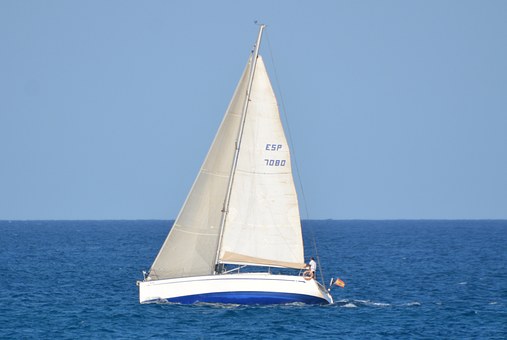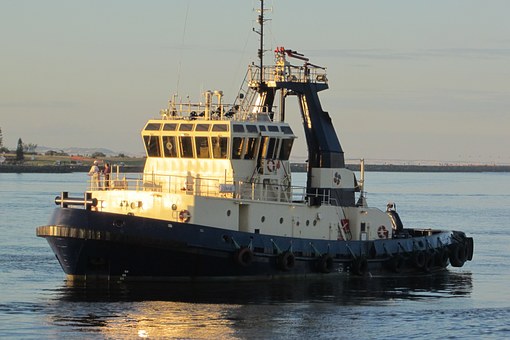Which is Better: an Aluminum or a Steel Sailboat?

Most sailboats are fiberglass these days, but if you are looking for a really strong sailboat
, you are likely to choose steel or aluminum. Fiberglass is fine for normal use, but if you are going cross oceans, or give your sailboat a hard life, metal is best. They are also good materials if you want to get your own design of sailboat built.The reason aluminum or steel are best is that metals are both strong and stiff, and when hit really hard, they bend - fiberglass and even the most advanced composites will break, and even shatter. Then the sailboat will almost certainly sink. A sailboat with a dent in the hull can keep going.
There are other advantages, too. Fiberglass boats usually have separate keels that are bolted in place. The bolts 'work' in the retaining holes in the hull, enlarging then slightly, and after a few years you are likely to get leaks. Worse still, if you press your sailboat really hard, the bolts can break,and you lose the keel. This happens quite often in racing, and can happen to cruising sailboats as well.
The keel of a steel or aluminum boat is formed as part of the hull, so it cannot come off - and the ballast of lead or steel is encapsulated inside, where it cannot move.

If you are looking for a 20-28 foot sailboat to cruise around rivers, estuaries and a little offshore cruising, then fiberglass is fine. But if you want to go further, or you want your boat to be of a particular design, choose aluminum or steel. Many firms offer excellent designs for metal sailboats, and some offer sets of panels that you weld together - or have welded together - usually complete with instructions.
Twenty years ago, it was much easier to weld steel than aluminum, but with modern welding sets and alloys, aluminum can be welded easily with just a little training - hours not weeks. Therefore, more and more sailboats -and smaller motor boats - are being made from aluminum.
But the next question is: Should I choose steel or aluminum? The things to be considered are:
1.Weight and weight distribution
2.Long life
3.Maintenance
1. Weight advantage of aluminum
Steel is stronger than aluminum, but this is not the advantage it seems with a sailboat because if the panels of the hull are too thin, they are difficult to weld without distortion, and you will end up with a hull with wavy panels. The minimum practical thickness is around 1/8 inch (3 mm) and an aluminum hull made from 3/16 inch (5 mm) plate is plenty strong enough for a 35-foot yacht and is lighter than the steel boat.
If you are building a 40 or 50 foot sailboat, the weight saving with aluminum over steel will be considerable - in all cases this allows the designer to put the weight where it is needed for a good motion at sea - in the keel. As a result, aluminum sailboats usually have a sea-kindly motion. With a racing boat, the reduced weight is an advantage, although a hull made completely from carbon fiber will be a bit lighter, but is brittle.
2.Long life
On the face of it, both steel and aluminum should last a long time, and both need some attention. Both can suffer from galvanic corrosion in salt water - especially in marinas - so you need more sacrificial anodes than with fiberglass, and you need to renew them regularly. Aluminum is at a slight disadvantage in this respect - you must maintain good anodes, but as these usually last more than a season this is not a problem.
Aluminum panels that are exposed to the atmosphere form an oxide film automatically, and this prevents further corrosion. So long as the panels are dry, they do not corrode. Therefore, it is best to leave most of the hull unpainted, and to coat the decks with non-slip panels - these are like rubber mats that are bonded in position - rather than non-slip paint for example.
With a little care, an aluminum hull will last a very long time. Steel is very different because it is always trying to corrode or rust away. It must be treated, then coated to give it protection. It is usually easy to see what is happening outside, and keep the hull in good shape, but not so easy to see what is happening in the bilges, and behind lockers and elsewhere. Almost always, after a few years, a steel hull will start to corrode on the inside, owing to condensation or water getting inside. Therefore, the steel boat is not so likely to last a long time without giving some trouble - unless it has very thick panels - like a ship, in which case it will be very heavy.
Expensive to Repair
When steel starts to rust badly, it costs a lot of money to repair. I have met several people who have had problems with steel sailboats. One couple I knew spent six months, working every day, to remove the rust from the hull of their steel sailboat. Fortunately, the hull was thick and had been well protected so it remained sound.
One sailboat that was about ten years old was found to have rusted badly through the whole hull- and needed repairing extensively, with new panels. The boat was worth about $30,000 in good condition, but it would cost $20,000 to strip the boat out for welding and then to refit it. On top of that the welding repairs would cost $10,000. In other words, the boat was almost worthless.
Another man I met had bought a 32 foot steel sailboat which was only a few years old. On the maiden voyage, he found water in the bilges which he discovered was leaking through the hull. He returned to port, got it safely to a suitable yard, and when I met him first he had started work on repairs.
This steel sailboat had cost $75,000, yet the hull was riddled with rust which in many places could be pushed through with a small screwdriver. He told me the rust was mostly along the weld joints and reinforcements.

I met him a year later, and he had finished welding up the hull. He had had to replace just about every panel below the water line, and was then fitting the boat out. He had help from his father and a friend, but he still reckoned it had cost him $70,000 to repair.
On balance, therefore, I recommend that you buy an aluminum sailboat rather than a steel one, and resist the temptation to paint the complete hull - just have a band painted on the topsides, and of course, epoxy coat the underwater hull before applying anti-fouling.
Which is Better: an Aluminum or a Steel Sailboat?
By: Jeremiah Slivka Getting Clear about What Boat you Want to Buy Naked Boating Tips On Choosing A Marine Battery For Your Boat Kashmir tourism: Inviting people for a wonderful stay in fascinating houseboats Kerala Backwater Houseboat Tours Hong Kong Dragon Boat Festival - Keeping A Folk Tale Alive Say Ahoy Matey While Wearing Boat Shoes Starting to Understand Boat Engines How to remove decals from boats and fiberglass Boat Trader Boat Shoes for mens and womens Sailing To The Azores Islands Womens Boat Shoes: A popular fashion accessory